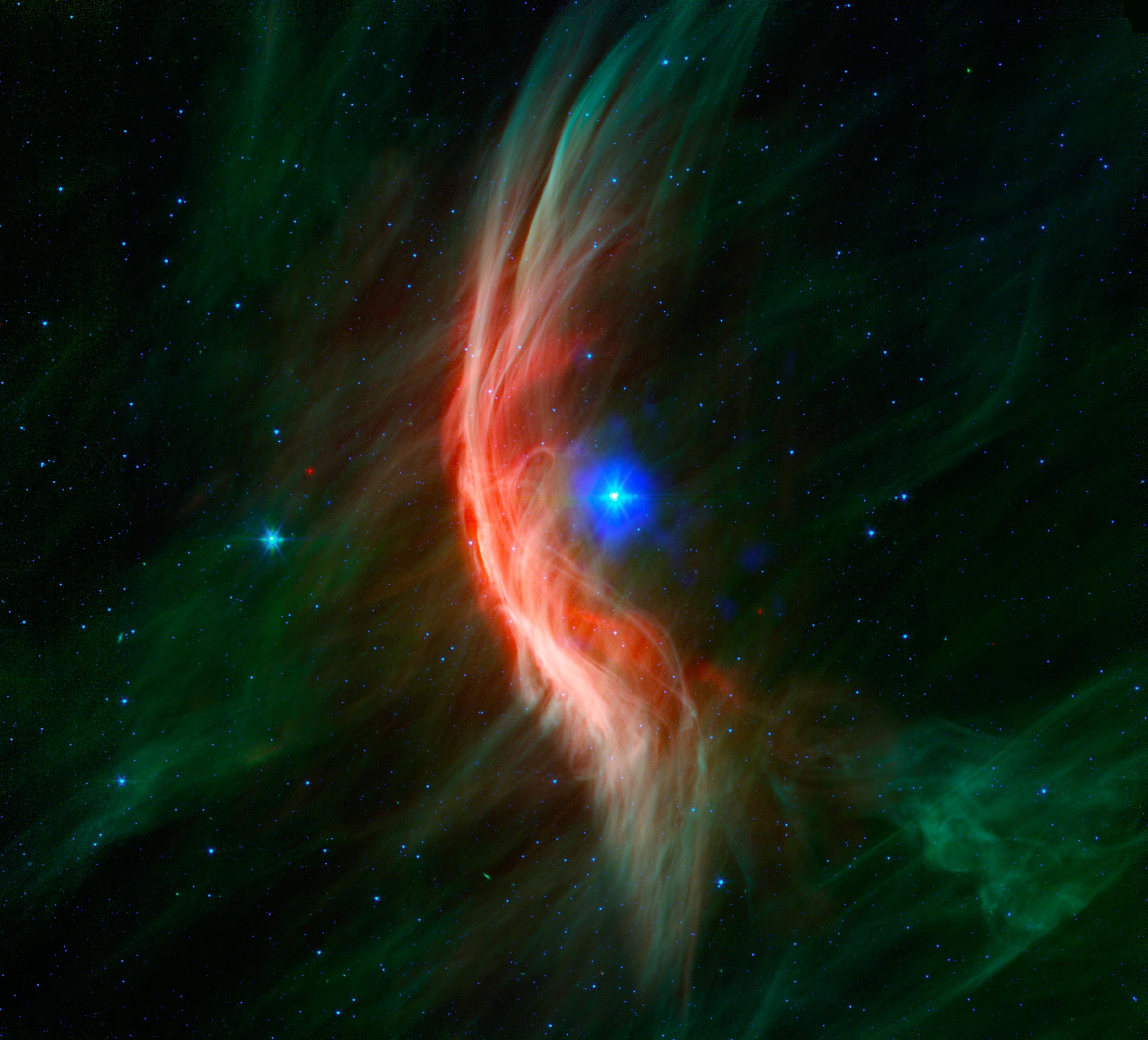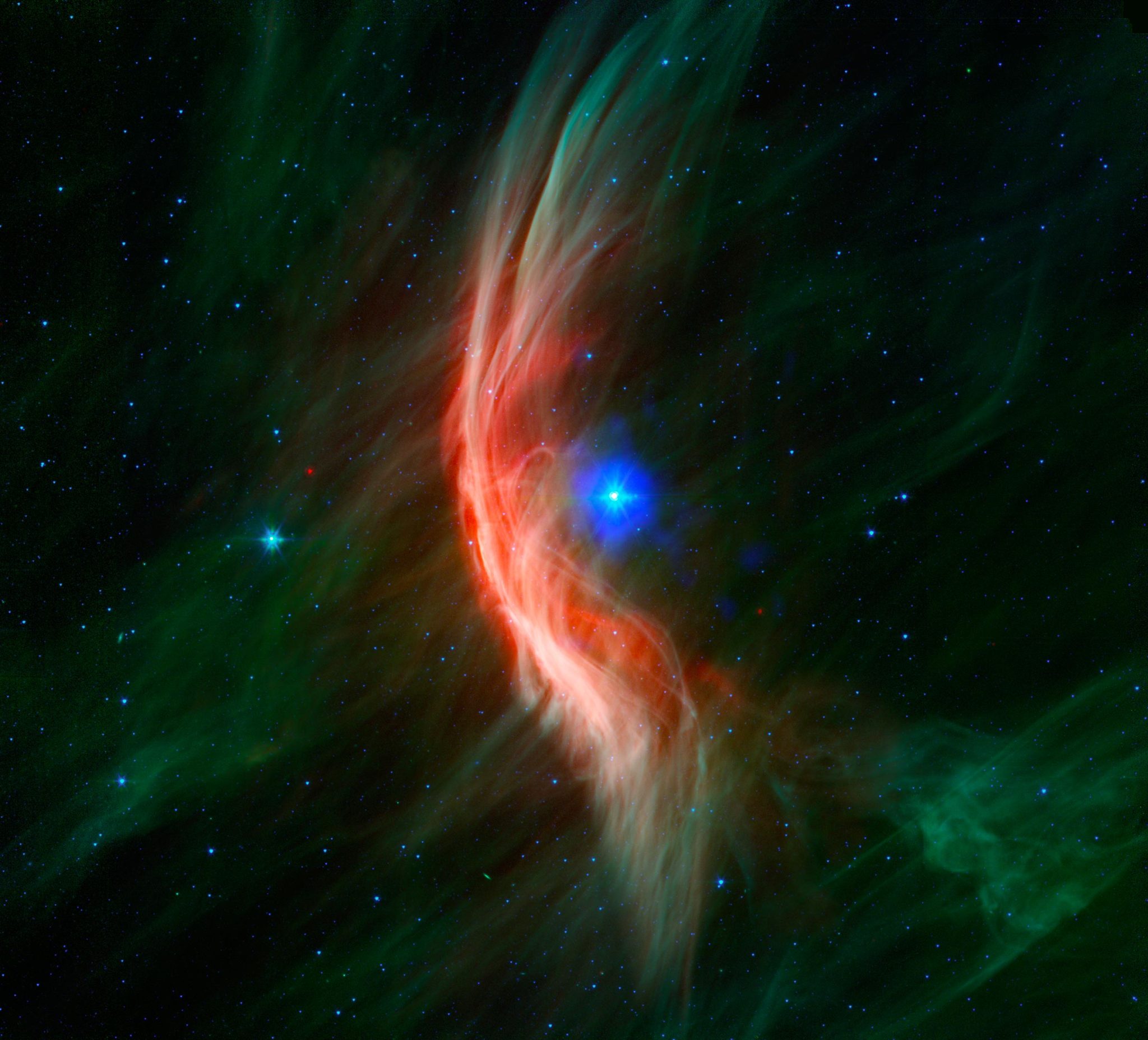

كانت زيتا أوفيوتشي ذات مرة في مدار قريب مع نجم آخر ، قبل أن يتم طردها عندما تم تدمير هذا الرفيق في انفجار مستعر أعظم. تكشف بيانات الأشعة تحت الحمراء من سبيتزر عن موجة صدمة مذهلة تشكلت من مادة تبتعد عن سطح النجم وتصطدم بالغاز في مسارها. تُظهر البيانات المأخوذة من شاندرا فقاعة من انبعاث الأشعة السينية الموجودة حول النجم ، والتي ينتجها الغاز الذي تم تسخينه بواسطة موجة الصدمة إلى عشرات الملايين من الدرجات. تساعد بيانات Chandra في سرد المزيد عن قصة هذا النجم الجامح. الائتمان: الأشعة السينية: NASA / CXC / Univ. كامبريدج / ج. سيسك رينيس وآخرون ؛ الراديو: NSF / NRAO / VLA ؛ بصري: PanSTARRS
- Zeta Ophiuchi هي نجمة واحدة من المحتمل أن يكون لها رفيق ذات يوم تم تدميره عندما تعرض للمستعر الأعظم.
- أدى انفجار المستعر الأعظم إلى إرسال زيتا أوفيوتشي ، التي شوهدت في سبيتزر (باللونين الأخضر والأحمر) وبيانات شاندرا (باللون الأزرق) ، إلى الفضاء.
- تنشأ الأشعة السينية التي اكتشفها تشاندرا من غاز تم تسخينه إلى ملايين الدرجات بتأثيرات موجة الصدمة.
- يعمل العلماء على مطابقة النماذج الحسابية لهذا الكائن لشرح البيانات التي تم الحصول عليها بأطوال موجية مختلفة.
https://www.youtube.com/watch؟v=-Q9cSNFDZ0c
Zeta Ophiuchi هي نجمة ذات ماض معقد ، حيث من المحتمل أن تكون قد طردت من مسقط رأسها بسبب انفجار نجمي قوي. نظرة مفصلة جديدة من قبل[{” attribute=””>NASA’s Chandra X-ray Observatory helps tell more of the history of this runaway star.
Located approximately 440 light-years from Earth, Zeta Ophiuchi is a hot star that is about 20 times more massive than the Sun. Evidence that Zeta Ophiuchi was once in close orbit with another star, before being ejected at about 100,000 miles per hour when this companion was destroyed in a supernova explosion over a million years ago has been provided by previous observations.
In fact, previously released infrared data from NASA’s now-retired Spitzer Space Telescope, seen in this new composite image, reveals a spectacular shock wave (red and green) that was formed by matter blowing away from the star’s surface and slamming into gas in its path. A bubble of X-ray emission (blue) located around the star, produced by gas that has been heated by the effects of the shock wave to tens of millions of degrees, is revealed by data from Chandra.
A team of astronomers has constructed the first detailed computer models of the shock wave. They have begun testing whether the models can explain the data obtained at different wavelengths, including X-ray, infrared, optical, and radio observations. All three of the different computer models predict fainter X-ray emissions than observed. In addition, the bubble of X-ray emission is brightest near the star, whereas two of the three computer models predict the X-ray emission should be brighter near the shock wave. The team of astronomers was led by Samuel Green from the Dublin Institute for Advanced Studies in Ireland.
https://www.youtube.com/watch؟v=t2w5nq9cU9A
في المستقبل ، يخطط هؤلاء العلماء لاختبار نماذج أكثر تعقيدًا بفيزياء إضافية – بما في ذلك تأثيرات الاضطراب وتسريع الجسيمات – لمعرفة ما إذا كان الاتفاق مع بيانات الأشعة السينية سيتحسن.
تم قبول ورقة تصف هذه النتائج في المجلة علم الفلك والفيزياء الفلكية. تم تحليل بيانات شاندرا المستخدمة هنا في الأصل بواسطة Jesús Toala من معهد الفيزياء الفلكية في الأندلس في إسبانيا ، والذي كتب أيضًا الاقتراح الذي أدى إلى الملاحظات.
المرجع: “الانبعاث الحراري من صدمات القوس. II. نماذج مغناطيسية هيدروديناميكية ثلاثية الأبعاد لزيتا أوفيوتشي “بقلم S. Green و J. Mackey و P. Kavanagh و TJ Haworth و M. Moutzouri و VV Gvaramadze ، مقبول ، علم الفلك والفيزياء الفلكية.
DOI: 10.1051 / 0004-6361 / 202243531
يدير مركز مارشال لرحلات الفضاء التابع لناسا برنامج شاندرا. يتحكم مركز شاندرا للأشعة السينية التابع لمرصد سميثسونيان للفيزياء الفلكية في العمليات العلمية من كامبريدج ، ماساتشوستس ، وعمليات الطيران من بيرلينجتون ، ماساتشوستس.

“هواة الإنترنت المتواضعين بشكل يثير الغضب. مثيري الشغب فخور. عاشق الويب. رجل أعمال. محامي الموسيقى الحائز على جوائز.”
